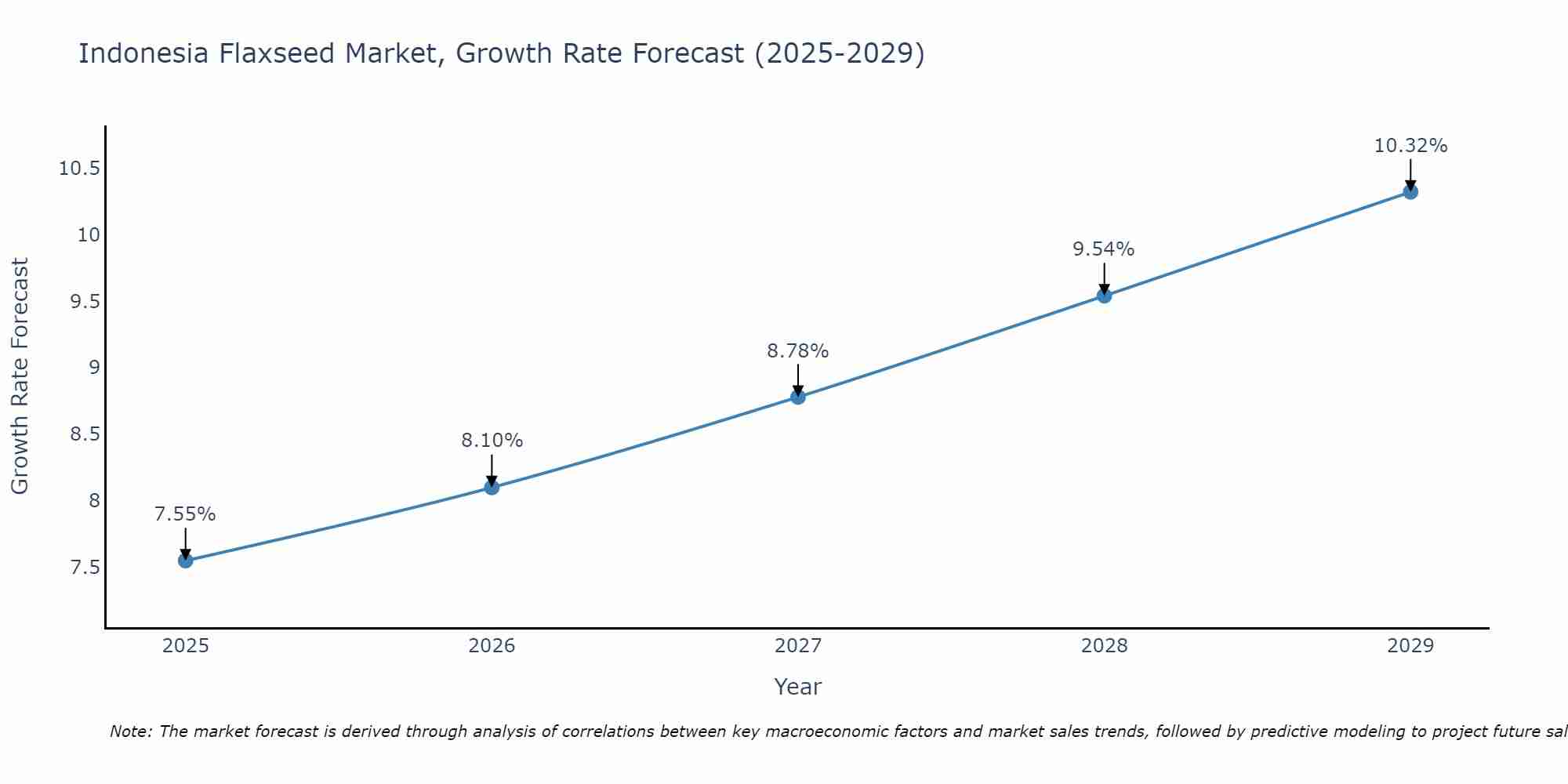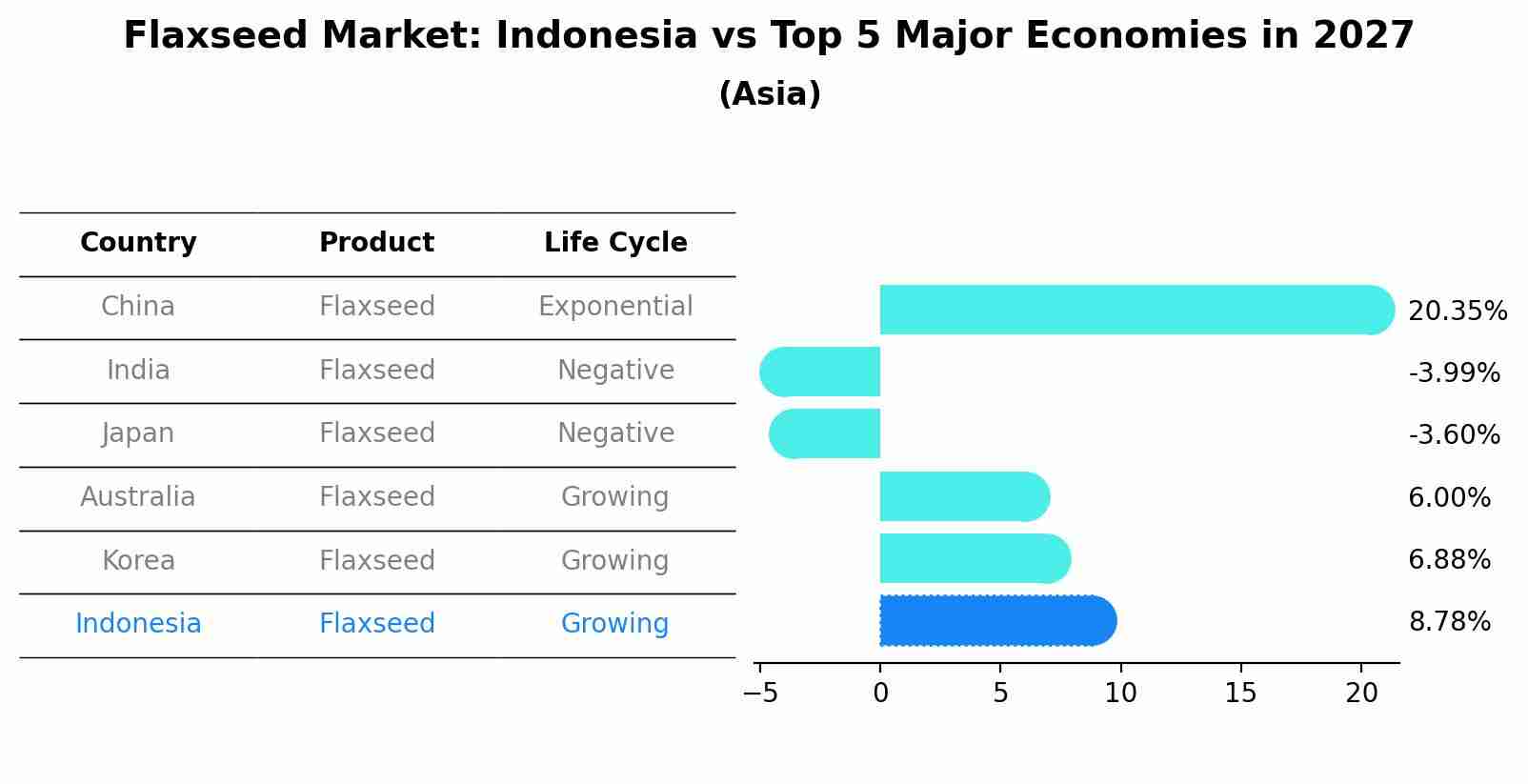Indonesia Flaxseed Market (2025-2031) Outlook | Forecast, Share, Industry, Growth, Trends, Companies, Size, Revenue, Analysis & Value
| Product Code: ETC088907 | Publication Date: Jul 2023 | Updated Date: Apr 2025 | Product Type: Report | |
| Publisher: 6Wresearch | No. of Pages: 70 | No. of Figures: 35 | No. of Tables: 5 | |
Indonesia Flaxseed Market Size Growth Rate
The Indonesia Flaxseed Market is poised for steady growth rate improvements from 2025 to 2029. Commencing at 7.55% in 2025, growth builds up to 10.32% by 2029.

Flaxseed Market: Indonesia vs Top 5 Major Economies in 2027 (Asia)
By 2027, the Flaxseed market in Indonesia is anticipated to reach a growth rate of 8.78%, as part of an increasingly competitive Asia region, where China remains at the forefront, supported by India, Japan, Australia and South Korea, driving innovations and market adoption across sectors.

Indonesia Flaxseed Market Synopsis
Indonesia is the second largest producer of flaxseed in Asia Pacific after India, with production estimated at 1.7 million tons in 2025. Flaxseed is used for a variety of purposes including food products, animal feed and medicinal products. Increased demand from health conscious consumers, increasing awareness about the nutritional benefits associated with flaxseed consumption and government initiatives to promote agricultural production are some of the key drivers aiding market growth in Indonesia. Additionally, rising disposable income has also enabled increased spending on premium food products which has further driven market demand for flaxseed in Indonesia.
Market Trends
The use of flaxseed as an ingredient across various food applications such as bakery items, snacks and energy bars have become increasingly popular among Indonesia consumers over the past few years due to its high fiber content and healthy omega-3 fatty acids profile. Moreover, manufacturers are incorporating it into packaged foods such as breakfast cereals and snack mixes to meet consumer preferences towards healthier options that can help reduce their risk for chronic diseases such as diabetes or heart disease. This trend is expected to continue driving demand during the forecast period 2025-2031 too.
Market Drivers
Increasing health consciousness among global population along with growing awareness about nutrition have been creating significant opportunities within this industry globally. In addition, rapid industrialization, urbanization & increasing purchasing power of middle class families are additionally helping boost sales within this sector. Further, increasing availability & affordability of processed foods containing flaxseeds act as catalysts propelling growth rate. Moreover, Government initiatives encouraging cultivation & usage of organic produce will propel market share over upcoming years.
COVID-19 Impact on the Market
The COVID-19 pandemic had negative impacts on all sectors including seed producers worldwide due to disrupted supply chains, reduced trade activities etc., leading to slow down in revenue generation within this space making it difficult for companies operating therein. However this situation was short lived owing strong recovery post lockdown scenario enabling players recuperate lost ground quickly thereby sustaining operations well going forward alongwith boosting sales figures substantially by end 2031.
Challenges of the Market
Availability of adulterated product poses major challenge thereby affecting quality standards being maintained by stakeholders operating herein & impacting reputation amongst customers adversely resulting discouraging performance results squeezing profit margins significantly.
Industry Key Players
Agro Inti Pelangi, PT Sumber Pangan Indonesia, Maju Bersama Sejahtera Abadi, Tradisyar Mandiri Utama, Sukses Makmur Jaya Sentosa, Rajawali Nusantara Indonesia.
Key Highlights of the Report:
- Indonesia Flaxseed Market Outlook
- Market Size of Indonesia Flaxseed Market, 2024
- Forecast of Indonesia Flaxseed Market, 2031
- Historical Data and Forecast of Indonesia Flaxseed Revenues & Volume for the Period 2021-2031
- Indonesia Flaxseed Market Trend Evolution
- Indonesia Flaxseed Market Drivers and Challenges
- Indonesia Flaxseed Price Trends
- Indonesia Flaxseed Porter's Five Forces
- Indonesia Flaxseed Industry Life Cycle
- Historical Data and Forecast of Indonesia Flaxseed Market Revenues & Volume By Type for the Period 2021-2031
- Historical Data and Forecast of Indonesia Flaxseed Market Revenues & Volume By Ground Seed for the Period 2021-2031
- Historical Data and Forecast of Indonesia Flaxseed Market Revenues & Volume By Whole Seed for the Period 2021-2031
- Historical Data and Forecast of Indonesia Flaxseed Market Revenues & Volume By Application for the Period 2021-2031
- Historical Data and Forecast of Indonesia Flaxseed Market Revenues & Volume By Food for the Period 2021-2031
- Historical Data and Forecast of Indonesia Flaxseed Market Revenues & Volume By Animal & Pet Food for the Period 2021-2031
- Historical Data and Forecast of Indonesia Flaxseed Market Revenues & Volume By Others for the Period 2021-2031
- Indonesia Flaxseed Import Export Trade Statistics
- Market Opportunity Assessment By Type
- Market Opportunity Assessment By Application
- Indonesia Flaxseed Top Companies Market Share
- Indonesia Flaxseed Competitive Benchmarking By Technical and Operational Parameters
- Indonesia Flaxseed Company Profiles
- Indonesia Flaxseed Key Strategic Recommendations
Frequently Asked Questions About the Market Study (FAQs):
1 Executive Summary |
2 Introduction |
2.1 Key Highlights of the Report |
2.2 Report Description |
2.3 Market Scope & Segmentation |
2.4 Research Methodology |
2.5 Assumptions |
3 Indonesia Flaxseed Market Overview |
3.1 Indonesia Country Macro Economic Indicators |
3.2 Indonesia Flaxseed Market Revenues & Volume, 2021 & 2031F |
3.3 Indonesia Flaxseed Market - Industry Life Cycle |
3.4 Indonesia Flaxseed Market - Porter's Five Forces |
3.5 Indonesia Flaxseed Market Revenues & Volume Share, By Type, 2021 & 2031F |
3.6 Indonesia Flaxseed Market Revenues & Volume Share, By Application, 2021 & 2031F |
4 Indonesia Flaxseed Market Dynamics |
4.1 Impact Analysis |
4.2 Market Drivers |
4.3 Market Restraints |
5 Indonesia Flaxseed Market Trends |
6 Indonesia Flaxseed Market, By Types |
6.1 Indonesia Flaxseed Market, By Type |
6.1.1 Overview and Analysis |
6.1.2 Indonesia Flaxseed Market Revenues & Volume, By Type, 2018 - 2031F |
6.1.3 Indonesia Flaxseed Market Revenues & Volume, By Ground Seed, 2018 - 2031F |
6.1.4 Indonesia Flaxseed Market Revenues & Volume, By Whole Seed, 2018 - 2031F |
6.2 Indonesia Flaxseed Market, By Application |
6.2.1 Overview and Analysis |
6.2.2 Indonesia Flaxseed Market Revenues & Volume, By Food, 2018 - 2031F |
6.2.3 Indonesia Flaxseed Market Revenues & Volume, By Animal & Pet Food, 2018 - 2031F |
6.2.4 Indonesia Flaxseed Market Revenues & Volume, By Others, 2018 - 2031F |
7 Indonesia Flaxseed Market Import-Export Trade Statistics |
7.1 Indonesia Flaxseed Market Export to Major Countries |
7.2 Indonesia Flaxseed Market Imports from Major Countries |
8 Indonesia Flaxseed Market Key Performance Indicators |
9 Indonesia Flaxseed Market - Opportunity Assessment |
9.1 Indonesia Flaxseed Market Opportunity Assessment, By Type, 2021 & 2031F |
9.2 Indonesia Flaxseed Market Opportunity Assessment, By Application, 2021 & 2031F |
10 Indonesia Flaxseed Market - Competitive Landscape |
10.1 Indonesia Flaxseed Market Revenue Share, By Companies, 2024 |
10.2 Indonesia Flaxseed Market Competitive Benchmarking, By Operating and Technical Parameters |
11 Company Profiles |
12 Recommendations |
13 Disclaimer |
- Single User License$ 1,995
- Department License$ 2,400
- Site License$ 3,120
- Global License$ 3,795
Search
Related Reports
- Middle East OLED Market (2025-2031) | Outlook, Forecast, Revenue, Growth, Companies, Analysis, Industry, Share, Trends, Value & Size
- Saudi Arabia Plant Maintenance Market (2025-2031) | Industry, Size, Growth, Revenue, Value, Companies, Forecast, Analysis, Share & Trends
- Taiwan Electric Truck Market (2025-2031) | Outlook, Industry, Revenue, Size, Forecast, Growth, Analysis, Share, Companies, Value & Trends
- South Korea Electric Bus Market (2025-2031) | Outlook, Industry, Companies, Analysis, Size, Revenue, Value, Forecast, Trends, Growth & Share
- Vietnam Electric Vehicle Charging Infrastructure Market (2025-2031) | Outlook, Analysis, Forecast, Trends, Growth, Share, Industry, Companies, Size, Value & Revenue
- Vietnam Meat Market (2025-2031) | Companies, Industry, Forecast, Value, Trends, Analysis, Share, Growth, Revenue, Size & Outlook
- Vietnam Spices Market (2025-2031) | Companies, Revenue, Share, Value, Growth, Trends, Industry, Forecast, Outlook, Size & Analysis
- Iran Portable Fire Extinguisher Market (2025-2031) | Value, Forecast, Companies, Industry, Analysis, Trends, Growth, Revenue, Size & Share
- Philippines Animal Feed Market (2025-2031) | Companies, industry, Size, Share, Revenue, Analysis, Forecast, Growth, Outlook
- India Lingerie Market (2025-2031) | Companies, Growth, Forecast, Outlook, Size, Value, Revenue, Share, Trends, Analysis & Industry
Industry Events and Analyst Meet
Our Clients
Whitepaper
- Middle East & Africa Commercial Security Market Click here to view more.
- Middle East & Africa Fire Safety Systems & Equipment Market Click here to view more.
- GCC Drone Market Click here to view more.
- Middle East Lighting Fixture Market Click here to view more.
- GCC Physical & Perimeter Security Market Click here to view more.
6WResearch In News
- Doha a strategic location for EV manufacturing hub: IPA Qatar
- Demand for luxury TVs surging in the GCC, says Samsung
- Empowering Growth: The Thriving Journey of Bangladesh’s Cable Industry
- Demand for luxury TVs surging in the GCC, says Samsung
- Video call with a traditional healer? Once unthinkable, it’s now common in South Africa
- Intelligent Buildings To Smooth GCC’s Path To Net Zero













